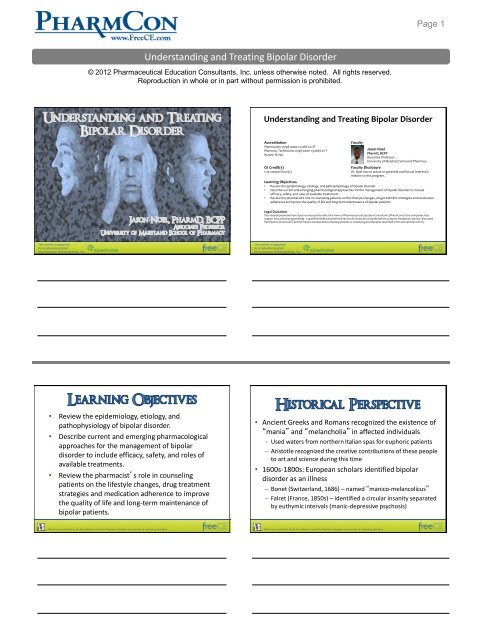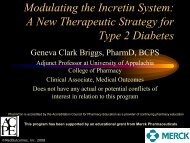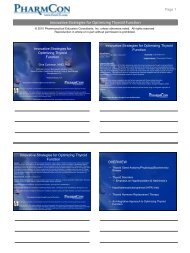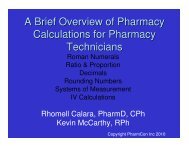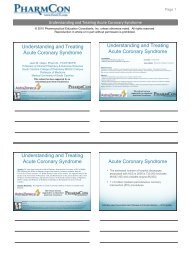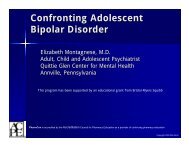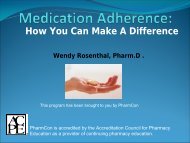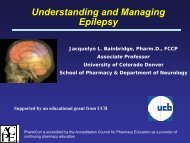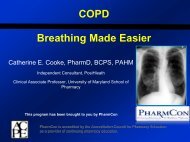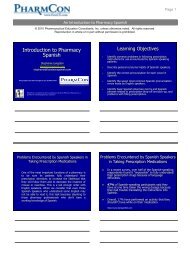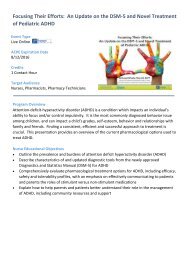Understanding and Treating Bipolar Disorder - Free CE
Understanding and Treating Bipolar Disorder - Free CE
Understanding and Treating Bipolar Disorder - Free CE
Create successful ePaper yourself
Turn your PDF publications into a flip-book with our unique Google optimized e-Paper software.
Page 1<strong>Underst<strong>and</strong>ing</strong> <strong>and</strong> <strong>Treating</strong> <strong>Bipolar</strong> <strong>Disorder</strong>© 2012 Pharmaceutical Education Consultants, Inc. unless otherwise noted. All rights reserved.Reproduction in whole or in part without permission is prohibited.<strong>Underst<strong>and</strong>ing</strong> <strong>and</strong> <strong>Treating</strong> <strong>Bipolar</strong> <strong>Disorder</strong>AccreditationFacultyPharmacists: 0798-0000-12-068-L01-PPharmacy Technicians: 0798-0000-13-068-L01-TJason NoelNurses: N-790PharmD, BCPPAssociate ProfessorUniversity of Maryl<strong>and</strong> School of Pharmacy<strong>CE</strong> Credit(s)Faculty Disclosure1.25 contact hour(s)Dr. Noel has no actual or potential conflicts of interest inrelation to this program.Learning Objectives• Review the epidemiology, etiology, <strong>and</strong> pathophysiology of bipolar disorder• Describe current <strong>and</strong> emerging pharmacological approaches for the management of bipolar disorder to includeefficacy, safety, <strong>and</strong> roles of available treatments• Review the pharmacist’s role in counseling patients on the lifestyle changes, drug treatment strategies <strong>and</strong> medicationadherence to improve the quality of life <strong>and</strong> long-term maintenance of bipolar patientsLegal DisclaimerThe material presented here does not necessarily reflect the views of Pharmaceutical Education Consultants (PharmCon) or the companies thatsupport educational programming. A qualified healthcare professional should always be consulted before using any therapeutic product discussed.Participants should verify all information <strong>and</strong> data before treating patients or employing any therapies described in this educational activity.This activity is supportedby an 2/20/2013 educational grant1from Sunovion Pharmaceuticals, Inc.This activity is supportedby an 2/20/2013 educational grant2from Sunovion Pharmaceuticals, Inc.• Review the epidemiology, etiology, <strong>and</strong>pathophysiology of bipolar disorder.• Describe current <strong>and</strong> emerging pharmacologicalapproaches for the management of bipolardisorder to include efficacy, safety, <strong>and</strong> roles ofavailable treatments.• Review the pharmacist’s role in counselingpatients on the lifestyle changes, drug treatmentstrategies <strong>and</strong> medication adherence to improvethe quality of life <strong>and</strong> long-term maintenance ofbipolar patients.• Ancient Greeks <strong>and</strong> Romans recognized the existence of“mania” <strong>and</strong> “melancholia” in affected individuals– Used waters from northern Italian spas for euphoric patients– Aristotle recognized the creative contributions of these peopleto art <strong>and</strong> science during this time• 1600s-1800s: European scholars identified bipolardisorder as an illness– Bonet (Switzerl<strong>and</strong>, 1686) – named “manico-melancolicus”– Falret (France, 1850s) – identified a circular insanity separatedby euthymic intervals (manic-depressive psychosis)PharmCon is accredited by the Accreditation Council for Pharmacy Education as a provider of continuing education.PharmCon is accredited by the Accreditation Council for Pharmacy Education as a provider of continuing education.


